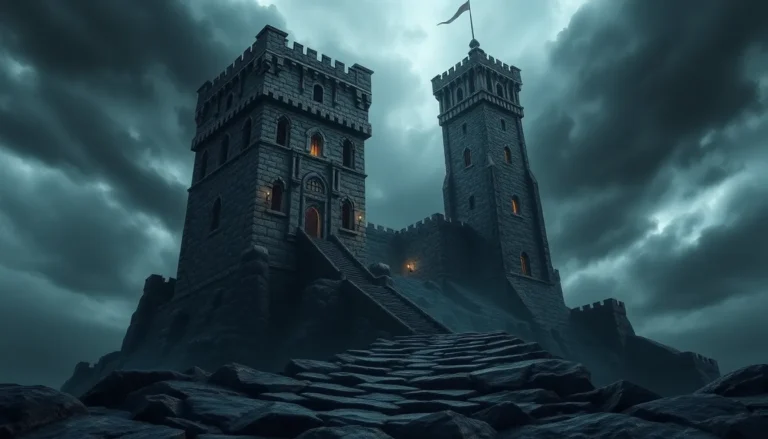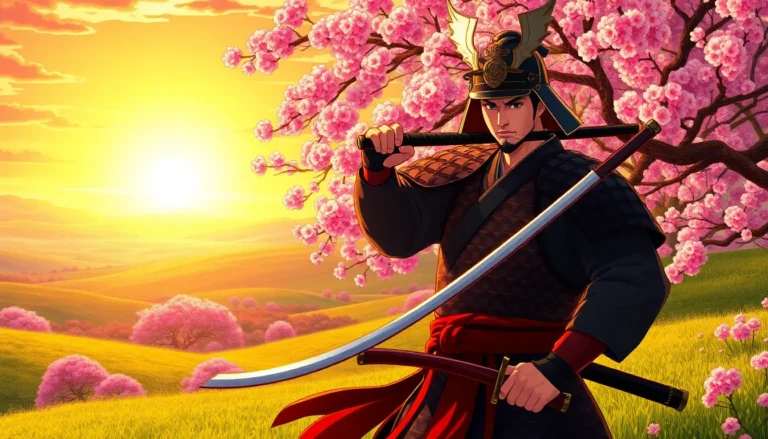Table of Contents
ToggleIn the stunning world of Ghost of Tsushima, players embark on a journey filled with breathtaking landscapes and heart-pounding action. Set against the backdrop of feudal Japan, this game isn’t just about slicing foes with a katana; it’s a gripping tale of honor, betrayal, and the struggle for freedom. With each act, players dive deeper into the life of Jin Sakai, a samurai torn between tradition and the necessity of becoming the Ghost.
Overview of Ghost of Tsushima
“Ghost of Tsushima” immerses players in a richly detailed open world set in feudal Japan. This action-adventure game showcases the stunning landscapes of Tsushima Island, enhancing the sense of exploration and adventure. Players experience the story through the eyes of Jin Sakai, a samurai warrior. The narrative intertwines themes of honor, betrayal, and freedom, presenting a profound journey that resonates with players.
Jin faces the Mongol invasion, challenging his samurai code to protect his home. His transformation into the Ghost symbolizes a shift from tradition to a new way of fighting. Numerous side quests and character arcs deepen the storytelling experience, allowing players to further engage with companion characters like Yuna and Sensei Ishikawa.
Dynamic combat mechanics offer various styles, from stealth tactics to head-on clashes, catering to diverse player preferences. Each encounter intertwines skill with strategy, encouraging players to adapt to enemies’ tactics. Upgrading abilities and customizing gear provides a sense of progression and personalization in the gameplay.
The game has received acclaim for its artistic design, fluid animation, and immersive sound design. Many critics highlight its cinematic quality, which enhances player engagement and elevates storytelling. As a result, “Ghost of Tsushima” stands out as a significant achievement in video game history.
Through its captivating landscapes and intense action, the game emphasizes the internal conflict of Jin Sakai. This struggle between his samurai heritage and the necessity to embrace a new identity forms the core of the gameplay experience. Each act invites players to reflect on the nature of honor, duty, and sacrifice in a tumultuous period.
Act 1: The Beginning
In Act 1 of “Ghost of Tsushima,” players are introduced to a world on the brink of chaos. The narrative sets the stage for Jin Sakai’s struggle as the Mongol invasion ravages Tsushima Island, forcing him to confront his values and role as a samurai.
Setting the Scene
Tsushima Island’s dynamic landscapes immerse players in feudal Japan’s beauty, from lush forests to serene beaches. The atmosphere reflects tranquility, abruptly shattered by the Mongolian forces. Players witness the initial invasions as the island’s peace is disrupted, highlighting the stakes Jin faces. This rich environment enhances exploration, where engaging with the surroundings reveals the culture and history of the era. The visuals and sounds deepen emotional connections, drawing players further into the unfolding crisis.
Key Characters Introduced
Key characters emerge in Act 1, shaping Jin’s journey. Jin Sakai represents the samurai duty embodying honor and loyalty. Yuna, a skilled thief, assists Jin, challenging his beliefs and pushing him toward unconventional tactics. Sensei Ishikawa, Jin’s mentor, provides wisdom and guidance, imparting traditional samurai skills. Each character’s motivations and backgrounds enrich the storyline, creating interpersonal dynamics that resonate with players. These relationships set the foundation for Jin’s transformation and the broader themes of sacrifice and resilience.
Act 2: The Struggle
In Act 2 of “Ghost of Tsushima,” the stakes escalate as Jin Sakai delves deeper into his role as the Ghost. He faces new challenges while grappling with his identity and the impact of his choices.
Major Plot Developments
Jin’s journey intensifies as he encounters the brutal Mongol leader Khotun Khan. Key allies, including Yuna and her brother, help him devise strategies against the invaders. Emotional confrontations reveal the personal toll of the war, showcasing Jin’s internal conflict. Betrayal surfaces as Jin learns of rival factions and their conflicting interests, heightening the narrative tension. Developments such as these contribute to the evolving storyline, pulling players into an engaging and rich experience.
New Gameplay Mechanics
Gameplay mechanics introduce fresh elements that enhance player interactions. Stealth tactics become essential as players navigate through enemy territory, utilizing new techniques for silent takedowns. Additional combat options emerge, allowing Jin to combine traditional samurai techniques with agile, ghostly maneuvers. Players unlock new abilities, such as fear tactics, influencing enemy behavior and strategy. Environmental interactions expand, offering creative ways to approach challenges and engage with the game’s stunning landscapes. These mechanics deepen immersion and provide variety in gameplay.
Act 3: The Climax
Act 3 marks the pinnacle of Jin Sakai’s journey as he faces the most intense challenges yet. The convergence of his dual identity as a samurai and the Ghost elevates the narrative’s stakes significantly.
Critical Battles
Confrontations with Khotun Khan become more dire in Act 3. Each battle showcases Jin’s growth and mastery of combat tactics. Players engage in climactic showdowns that not only test skills but also redefine Jin’s ethos. With the situation escalating, alliances shift, lurking threats appear, and the outcome of Tsushima Island hangs in the balance. Players must adapt their strategies, utilizing stealth and direct combat to navigate these critical moments. This act combines breathtaking visuals with strategic gameplay, ensuring memorable encounters that resonate deeply.
Resolution of Subplots
Conflicts from earlier acts reach a resolution in this segment. Jin confronts personal demons and unravels key betrayals, revealing intricate layers of character development. Relationships with Yuna and Sensei Ishikawa evolve significantly, reflecting growth and sacrifice. The fates of allies become intertwined, underscoring the importance of unity against a common foe. Players witness the culmination of various side quests, each tying back into the larger narrative, enhancing thematic depth. Every subplot wraps up, emphasizing the toll of war on Jin and his companions while reinforcing the core messages of honor and sacrifice.
The Impact of Ghost of Tsushima Acts
Ghost of Tsushima’s acts profoundly influence gameplay and narrative structure. Act 1 introduces critical characters and sets the tone for Jin Sakai’s journey. Players experience the gravity of the Mongol invasion on Tsushima Island, amplifying engagement with the unfolding story.
Act 2 heightens emotional stakes as Jin struggles with his identity as both a samurai and the Ghost. Key plot developments, such as encounters with Khotun Khan, unveil the harsh realities of war. Emotional confrontations contribute to character depth, showcasing the personal toll of conflict.
Act 3 culminates in intense battles that challenge Jin’s evolution. These climactic moments showcase his mastery of combat and solidify his role as a beacon of hope for Tsushima. The resolution of earlier conflicts enhances character arcs and reinforces themes of sacrifice and honor.
Conversations between Jin, Yuna, and Sensei Ishikawa deepen relationships, illustrating the impact of choices made throughout the journey. Players notice the greater emphasis on trust and betrayal during the final act, making decisions feel more consequential.
Environmental elements within each act provide immersive experiences that connect players to the historical context of feudal Japan. The open world of Tsushima invites exploration, enhancing the sense of discovery in each act.
Every act builds on the last, creating a cohesive narrative that resonates with players. Emotional stakes remain high, reflecting both individual and collective struggles during the Mongol invasion. Ghost of Tsushima’s acts offer profound insights into honor, duty, and the nuances of personal transformation amidst chaos.
Conclusion
The journey through “Ghost of Tsushima” offers players a profound exploration of identity and sacrifice. Each act builds upon the last, weaving a narrative that challenges traditional notions of honor while immersing players in the stunning landscapes of feudal Japan.
As Jin Sakai transforms from a samurai into the Ghost, the stakes escalate, revealing the complexities of his character and the relationships he forges. The game’s rich storytelling and dynamic gameplay mechanics ensure that players are not just passive observers but active participants in Jin’s quest for freedom.
Ultimately, “Ghost of Tsushima” leaves a lasting impact, inviting players to reflect on their choices and the consequences that follow in a world shaped by conflict and resilience.




